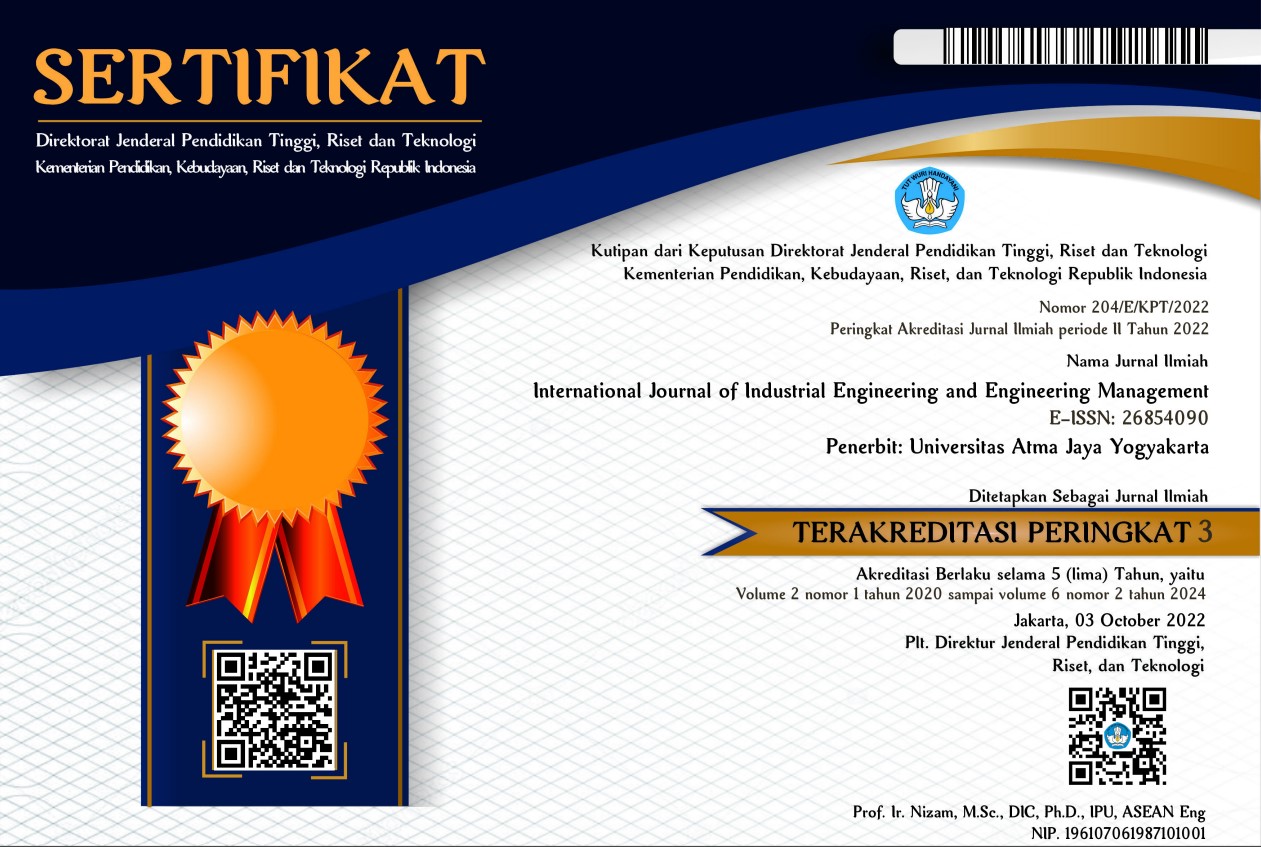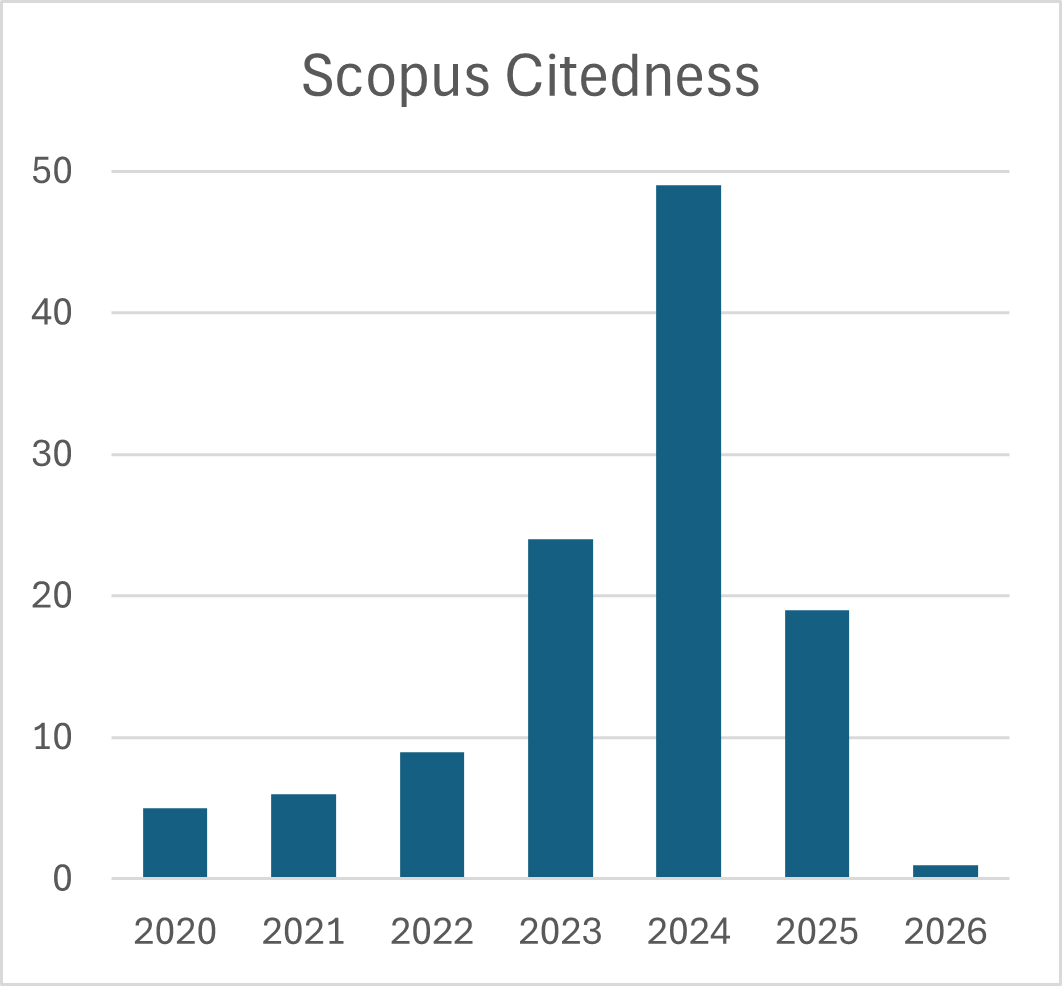Low Wear Rate Selection of Nylon 6-Boron Nitride (PA6/BN) Composite During Composite Development Using Grey Relational Analysis Through the Direct and Indirect Factors of Taguchi Method
DOI:
https://doi.org/10.24002/ijieem.v6i1.7734Keywords:
Grey relational analysis, wear performance, nylon 6, boron nitrideAbstract
Wear performance has been evaluated for mechanical equipment using normal load, sliding speed, and sliding distance, but aspect ratios have been traditionally ignored in the literature. Also, limited studies have analyzed wear performance with sparse information. In this study, a grey relational analysis (GRA) technique is proposed for the wear performance analysis of nylon 6/boron nitride composite using aspect ratios. A complete divergence is made from the literature where the aspect ratios of the particulate weight of the composite, normal load, sliding speed, and sliding distance are treated in direct and aspect ratios of 12 cases where the reciprocals of factors, their squares and cubes are considered. Results show that the proposed method of GRA is feasible and offers an adequate illustration of the indices of the parameters of the wear process as opposed to the present method of Taguchi that exists in the literature. A key result is from case 2, which shows that experimental trial 9 with the grey relational grade of 1.00 has the lowest wear rate. The corresponding values of the parameters are 0.05 of the 1/NL parameter, while the SD parameter is 500. This is interpreted as 0.05N-1 of the reciprocal of normal load and 500m for the sliding distance. The principal contribution of this research is the introduction of the grey relational analysis to reduce the wear rate of nylon 6-boron nitride composite. The proposed method is useful as a planning tool for the maintenance engineer to monitor the health of equipment in practice.
References
Adekoya, A.A., Adedeji, W.O., Oke, S.A., & Rajan, A.J. (2023). Developing optimal wear performance for nylon 6 loaded up with Boron Nitride (PA6/BN) composites using Taguchi direct and aspect ratio-based Taguchi-Pareto method. Journal of Engineering and Applied Science, 70(1), Article 19
Ajibade, O.A., Agunsoye, J.O., & Oke, S.A. (2018). Optimisation of wear parameters of dual filler epoxy composites using the grey relational analysis. Annals of Faculty Engineering Hunedoara – International Journal of Engineering, 16(4), 123–142
Bahadur, S., Gong, D., & Anderegg, J.W. (1995). Studies of worn surfaces and the transfer film formed in sliding by CuS-filled and carbon fiber-reinforced nylon against a steel surface. Wear, 181, 227–235
Boopathy, G., Prakash, J.U., Gurusami, K., & Kumar, J.S.P. (2022). Investigation on process parameters for injection moulding of nylon 6/SiC and nylon 6/B4C composites. Materials Today: Proceedings, 52(3), 1676–1681
Bose, S., & Mahanwar, P.A. (2004). Effect of particle size of filler on properties of nylon-6. Journal of Minerals & Materials Characterization & Engineering, 3(1), 23–31
Dasari, A., Yu, Z.Z., & Mai, Y.W. (2009). Fundamental aspects and recent progress on wear/scratch damage in polymer nanocomposites. Materials Science and Engineering: R: Reports, 63(2), 31–80
Friedrich, K. (2018). Polymer composites for tribological applications. Advanced Industrial and Engineering Polymer Research, 1(1), 3–39
Gao, P.P., Sun, Z.B., Mao, Y.J., Pan, M., Ji, X., Tang, J.H., Dai K., Lin H., Zhong G-J. & Li, Z.M. (2021). Tribological performances and self-lubricating mechanism of monomer casting nylon-6 composite coatings containing lube base oil-loaded microcapsules. Progress in Organic Coatings, 160, Article 106528.
Hriberšek, M., & Kulovec, S. (2022). Study of the glass fibres and internal lubricants influence in a polyamide 66 matrix on the wear evolution of polyacetal and polyamide 66 based gears in a meshing process. Engineering Failure Analysis, 134, Article 106071
Hutchings, I., & Shipway, P. (2017). Tribology: friction and wear of engineering materials, 165–236. Elsevier
Huang, S., Pan, B., Xie, M., Gao, J., Zhao, G., Niu, Y., & Wang, H. (2021). Synergistic effects of graphene oxide and paraffin wax on the tribological properties of monomer casting nylon-6 composites. Tribology International, 154, Article 106726
Ighravwe, D.E., Oke, S.A., & Adebiyi, K.A. (2018). Selection of an optimal neural network architecture for maintenance workforce size prediction using grey relational analysis. Engineering & Applied Science Research, 45(1), 1–7
Khalaj, M., Golkhatmi, S.Z., Alem, S.A.A., Baghchesaraee, K., Azar, M.H., & Angizi, S. (2020). Recent progress in the study of thermal properties and tribological behaviors of hexagonal boron nitride-reinforced composites. Journal of composites science, 4(3), Article 116
Kumar, K.S., & Reddy, A.C. (2020). Investigation on mechanical properties and wear performance of Nylon-6/Boron Nitride polymer composites by using Taguchi Technique. Results in Materials, 5, Article 100070
Li, Z.Y., Cai, Z.B., Wu, Y.P., & Zhu, M.H. (2017). Effect of nitrogen ion implantation dose on torsional fretting wear behavior of titanium and its alloy. Transactions of Nonferrous Metals Society of China, 27(2), 324–335
Mistry, M., & Randhawa, K.S. (2020). Investigations of the influence of hexagonal boron nitride particulates on mechanical & tribological properties of PA66. Journal of Physics: Conference Series, 1706(1), Article 012180
Myshkin, N.K., Petrokovets, M.I., & Kovalev, A.V. (2005). Tribology of polymers: Adhesion, friction, wear, and mass-transfer. Tribology International, 38(11-12), 910–921
Okponyia, K.O., & Oke, S.A. (2021). Process optimisation regarding overall equipment effectiveness of tyre manufacturing using response surface methodology and grey relational analysis. Engineering Access, 7(2), 109–125
Onyegiri, I.E., & Oke, S.A. (2017). A grey relational analytical approach to safety performance assessment in an aviation industry of a developing country. Engineering and applied science research, 44(1), 1–15
Pawar, D.S., & Abhang, L.B. (2022). Experimental investigation and prediction of wear behavior of polymeric composites. Materials Today: Proceedings, 62, 7255–7260
Pujar, V., Devarajaiah, R.M., Suresha, B., & Bharat, V. (2021). A review on mechanical and wear properties of fiber-reinforced thermoset composites with ceramic and lubricating fillers. Materials Today: Proceedings, 46, 7701–7710
Singh, P.K., & Singh, A.K. (2017). An investigation on the effects of the various techniques over the performance and durability of polymer gears. Materials Today: Proceedings, 4(2), 1606–1614
Zhang, K., Liu, K., Gao, T., Qiao, Y., Zhang, Y., Liu, X., Wang, W. & Ye, J. (2021). The unrecognized importance of roughness directionality to polymer wear. Wear, 486, Article 204084
Downloads
Published
How to Cite
Issue
Section
License
Copyright (c) 2024 Abdulganiyu Adegboyega Adekoya, John Rajan, Swaminathan Jose, Sunday Ayoola Oke, Samuel Bolaji Aderibigbe, Samson Oluwaseun Odudare

This work is licensed under a Creative Commons Attribution 4.0 International License.








